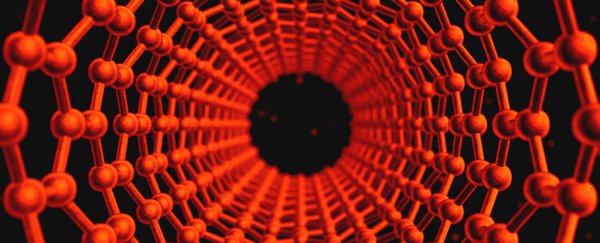It's official: graphene has been made into a superconductor in its natural state - which means electrical current can flow through it with zero resistance.
Last year, physicists managed to do this by doping graphene with calcium atoms, but this is the first time researchers have achieved superconductivity in the material without having to alter it. And the results so far show that the material achieves an incredibly rare type of superconductivity that's even crazier and more powerful than scientists expected.
The new research is a big deal even for a material as innately impressive as graphene, seeing as superconductivity is the key to more efficient electronics, better power grids, and new medical technology.
"It has long been postulated that, under the right conditions, graphene should undergo a superconducting transition, but can't," said one of the researchers, Jason Robinson from the University of Cambridge in the UK.
Now, he says his team has managed to awaken that ability. And it appears graphene isn't just a normal superconductor - it could be conducting current with no resistance as a result of an unconfirmed and elusive type of superconductivity called p-wave state. Further research is needed to confirm this result, but it's a pretty intriguing possibility.
Already an over-achiever, graphene is a two-dimensional sheet of carbon atoms that's super flexible, harder than diamond, and stronger than steel.
But since its discovery in 2004, researchers have suspected that graphene might also have the ability to be a superconductor - which means it could shuttle electrons through it with no resistance at all.
Even materials that are good conductors are still inefficient in comparison to superconductors - for example, energy companies lose about 7 percent of their energy as heat as a result of resistance in the grid.
We already use superconducting materials to create the strong magnetic fields needed in MRI machines and maglev trains, but right now, these materials only become superconductive at temperatures of around –269 degrees Celsius (–452.2 degrees Fahrenheit), which is incredibly expensive, and not exactly practical.
If we could find a way to achieve superconductivity sustainably and at high temperatures, it would open up a the possibility of supercomputers that run without resistance and more efficient medical technology - and graphene is often thought of as a prime candidate for achieving this, given all of its other weird and wonderful properties.
Researchers succeeded in making graphene a superconductor last year by inserting calcium atoms into its lattice. And other teams have achieved a similar result by placing it on a superconducting material.
But in the new study, researchers from the University of Cambridge were able to activate the dormant potential of graphene without it being influenced by another material.
"Placing graphene on a metal can dramatically alter the properties so it is technically no longer behaving as we would expect," said one of the team, Angelo di Bernardo.
"What you see is not graphene's intrinsic superconductivity, but simply that of the underlying superconductor being passed on."
Instead, the team achieved superconductivity by coupling it with a material called praseodymium cerium copper oxide (PCCO).
That might sound similar to what happened in previous experiments - after all, they're still putting graphene on top of another material - but the difference here is that PCCO is a type of superconducting material called a cuprate, which has well-understood electronic properties.
So the team was able to clearly distinguish the superconductivity in PCCO from the superconductivity in graphene.
And what they saw was crazier than they'd expected.
Superconductivity occurs when electrons pair up and travel more efficiently through a material.
The spin alignment, or symmetry, of these electron pairs changes depending on the type of superconductivity involved. For example, in PCCO, the electrons pair up with a spin state that's antiparallel, which is called d-wave state.
But what the team saw happening in graphene was very different - they found evidence of a rare and still unverified type of superconductivity called p-wave state occurring.
"What we saw in the graphene was, in other words, a very different type of superconductivity than in PCCO," said Robinson.
"This was a really important step because it meant that we knew the superconductivity was not coming from outside it and that the PCCO was therefore only required to unleash the intrinsic superconductivity of graphene."
It remains unclear exactly what kind of superconductivity the team unleashed in graphene - but if it's confirmed that it really is the elusive p-wave form, it could prove once and for all that this type of superconductivity exists, and allow researchers to study it properly for the first time.
P-wave superconductivity was first proposed in 1994, when Japanese researchers found evidence of it occurring in a crystal material called strontium ruthenate. But the crystal is too bulky to study it well enough to achieve the type of proof scientists need to confirm that the state exists.
If it's happening in graphene, it would be a lot easier to investigate.
"If p-wave superconductivity is indeed being created in graphene, graphene could be used as a scaffold for the creation and exploration of a whole new spectrum of superconducting devices for fundamental and applied research areas," said Robinson.
"Such experiments would necessarily lead to new science through a better understanding of p-wave superconductivity, and how it behaves in different devices and settings."
Not only that, but the team suggests that graphene could be the key to unlocking superconductivity above –269 degrees Celsius (-452.2 degrees Fahrenheit), and could be used inside supercomputers and other technologies to make them more efficient.
Other research teams will no doubt be racing to verify this result in their own labs and start experimenting with this new, awakened state of graphene, so watch this space.
The research has been published in Nature Communications.
